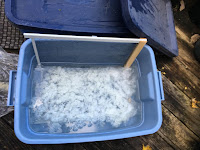How I felt about felting
I did it, I bit the bullet and started to wash the fleece, step 1 in
the process of “what am I going to do with all this loot (3 fleeces)?”. Was anxious about unintentionally felting it,
so was careful to not agitating it much.
Method: After consulting some
experts and reading online, I took a deep breath and put 3 Rubbermaid bins in the
yard.
Put hot tap water in the first
with some Dawn dish soap, agitating the soap some. Got 2 small adjustable window screens, split the
2 halves, put a layer of wool on one screen put the other screen on top of it
and set it in the soapy bin, gently lifting up and down a couple times, put a
lid on the bin and let it sit 15 minutes. Filled a second bin with only slightly cooler water than the first bin and
again added some soap and agitated it some.
Then lifted the 1st screens with wool out of bin 1, letting the
water drain into the bin, and submerging screens and wool in bin 2, lifting/submerging
slowly a couple times, then letting sit 15 minutes. Finally lifted the fleece from bin 2, letting excess
water drain and put it in slightly cooler (still pretty warm) water without
soap to rinse. Lifted it out
of bin 3, letting excess water drain, and put it on a large window screen across
2 chairs to dry.

| ||||||
It wasn’t
dry by evening so put it in the basement (which is pretty dry and has a dehumidifier). Research indicated it should dry until you
think it feels dry, then dry some more. I
kept turning it over to make sure it all dried and was finally rewarded with
a laundry basket full of white fluffy clouds!
Was surprised at the difference. The picture at right shows some unwashed (beige) sitting on the washed (white).
Discussion: After the
initial wash I learned:
1.
The water doesn’t need to be as hot (research online
suggested it should be hot tap water to get the lanolin out and shouldn’t be
much cooler in subsequent baths, that shocking it with cooler water would make the
wool felt and cooler water would allow the lanolin to reattach to the wool),
but warm (not as hot) on a second attempt seems to work.
2.
The wool doesn’t have to sit in the soap as long--not
everyone likes all the lanolin out, and wool spun in the grease (with its
lanolin) is something people have used forever to make garments that are more
waterproof—then again, in the past who had the luxury or time to use hot water and
soap on wool?
3.
The water may not need to be changed each time a
new section of wool is dunked (if the water’s dirty after the first, you may
want to change it, but you can do another one or 2 without adverse effects if
it’s not too dirty).
4.
What went in ivory came out of the wash bright white. WOW.
5.
In places where the wool was too thick it came
out yellowish (in comparison to the white), but a second wash
seemed to work. Gently pulling the thicker
wool pieces apart before they get dunked helps and slight agitation of thicker
pieces in the water to move soapy water between the fibers seems to be ok.
Conclusion:
Unnecessary anxiety--seems wool’s a little
less finicky/fragile (or at least this Border Leicester is) than I imagined. A wise woman made me realize, why stress about felting--if you felt it you just have a different project. Now I kind of want to felt. Have to keep thinking lemonade, or maybe lemon bars.... I have a lot to learn, but I’m liking this.









Comments
Post a Comment